Can I Reheat Prime Rib in Beef Broth to Get to Medium
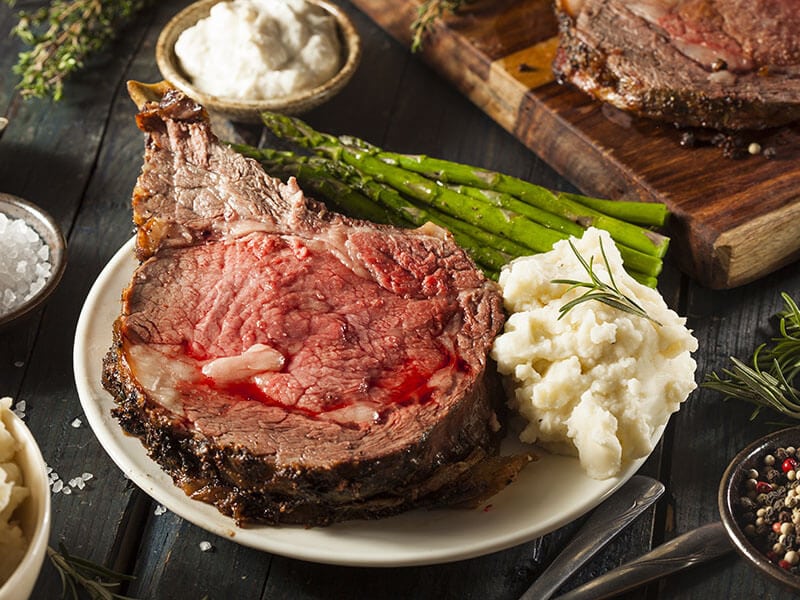
How To Reheat Prime Ribs? You wake up in the morning after a party night and go to your kitchen to take something that can feed your hungry belly. Then you find the beautiful rosy leftover prime rib. But you probably don't know how to reheat them.
Don't worry. Reheating prime ribs is not as hard as you thought. In this post, I will tell you the best ways to reheat your prime rib. And I'm sure you still can have another delicious meal with your juicy leftover prime rib.
What? Juicy leftover prime rib? Yep. You don't hear it wrong!
How To Reheat Your Prime Rib Properly?
Many people think that they can't reheat prime rib without sacrificing its succulent texture and fresh taste. Yes, they may be right. However, it's simply because they don't know how to reheat properly.
Here are my five best way to help you reheat you prime rib:
- Reheat with a steamer
- Reheat with an oven
- Reheat with a microwave
- Reheat with an air fryer
- Reheat with a sous vide
These ways sound very simple, but believe me, you can learn some useful tricks from my post!
Prime Rib – What You Need To Know
Prime rib, also known as "standing rib roast," is a cut from the primal rib. However, don't get it wrong with the ribeye. Though prime rib and ribeye come from the same cut, prime rib is mostly bone-in. (1)
The meat in less active parts tends to be softer. And obviously, cows spend all of their life working mainly by their four legs instead of their back, so it's easy to know why the prime rib – the meaty part on their back – can be so incredibly tender.
With the well marble running throughout the meat, prime rib has a decent amount of fat to protect it from drying out. You cannot keep your mouth from watering when standing in front of a prime rib. Tender, juicy, and astonishingly flavorful, all of these traits make it the best seller in a restaurant!
And when you're feeling like jazzing up your meal, there are a wide range of dishes to make with leftover prime rib as well. So if you feel like reheating prime rib might not be able to satisfy your taste buds, don't fret; there are still many options for you to consider.
Should You Reheat Your Prime Rib?
Of course, you should!
A leftover prime rib is usually cold served with sandwiches in a lazy morning to keep its juiciness. I clearly know you're afraid of losing its tender texture. But hey, re-heated prime rib is not a bad thing like you thought.
Let's reheat it with the right techniques, and your prime rib can come back with a completely new appearance. Are you curious about "the right technique" I have just mentioned?
If yes, here we go!
"Before The Screen" – Before Reheating Your Prime Rib
Before you do anything with your leftover prime rib, I would tell you some keys that you need to keep in mind.
1. Keep Foil On Your Hand
You might think aluminum foils are only used in barbecue parties or picnics with grilled meats and corn? Actually, they're applied even in-home cooking for their various uses. From being a way to rewarm tacos to substituting wax paper, aluminum foil has a wide range of applications.
A foil is a must-have item during your reheating process. It can help you to wrap your prime rib on for better reheating. On the other hand, your foil can be a high-quality barrier that protects your prime rib from over-reheating.
It keeps your prime rib moist, tender and juicy in the oven on the second cook.
You find it's unnecessary? Common, you don't want to eat a dried and burned leftover prime rib, do you?
2. Pay Attention To Prime Rib Slice Thickness
Preventing your prime rib from drying out is not as hard as it might sound. By noting the thickness of your prime rib slices, you can avoid breaking them down.
So, what is the appropriate thickness for a cut of prime rib? 0.5 inches? No, it's not enough. You need to have at least a 1-inch thick cut of prime rib when you are going to reheat it. A 1-inch cut will help you out of losing the juiciness.
3. Broth – A Treasured Companion For Your Prime Rib
When reheating your prime rib, there are two things that you cannot leave behind. The first one, as I reveal above, is foil. The second one surely is the broth.
The broth will provide the moisture for your prime rib when reheating. With a few tablespoons of broth, a perfect stunning prime rib will be displayed in front of you. Your leftover prime rib will look like it just came off the grill from a 3-star restaurant!
You ask me about the broth kind? Well, an au jus (a type of meat broth) will be the best companion!
You don't want to know how to make au jus? Well, it's easy! With beef fat drippings (or butter), all-purpose flour, back pepper and salt, you will have a delicious au jus!
Note: Take the in-store beef broth for replacement if you're too busy to cook!
You should see the video below:
"Action!" – 5 Ways To Reheat Your Leftover Prime Rib
Just like knowing the tricks to tell when your ribs are ready is very important, it's equally vital to learn the proper way to reheat prime ribs. Even with the best ribs, most premium ingredients, or state-of-the-art cookwares, cooking and reheating them incorrectly will result in dry ribs.
So, without further ado, let's check out the best methods to reheat prime ribs. Your leftover prime rib will be ready for breakfast or dinner after just a couple of minutes.
1. Reheating By A Steamer – My Top Recommendation!
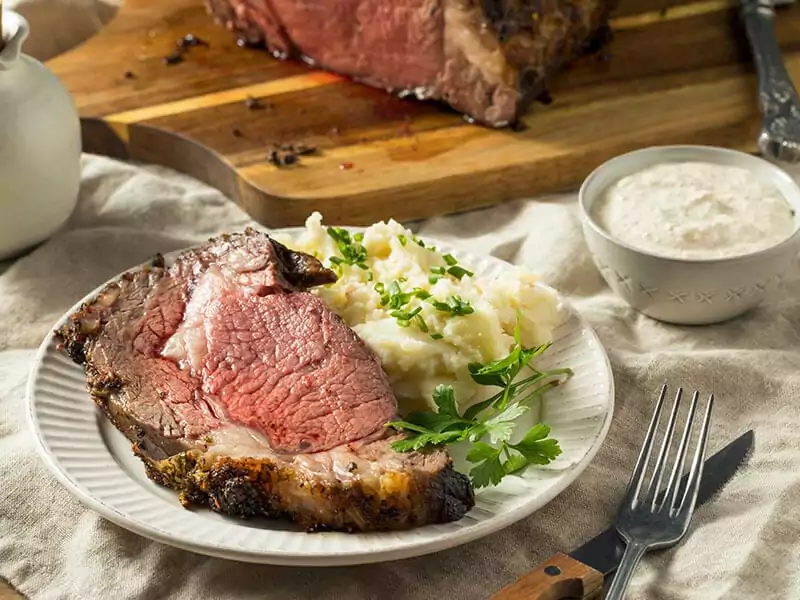
The inside of a steamer is an ideal place for your prime rib. It is always my first pick even if I have a microwave. The heat from the water in the steamer will keep your prime rib as moist as it can be. Now, let's go and discover my tricks!
What You Should Prepare:
- Your steamer
- 1-inch cut prime rib
- Aluminum foil
- Au jus (or beef broth)
- A thermometer
What You Should Do:
Step 1: Pour some water in the bottom of your steamer pot (about 1-3 inches of water will be the best).
Step 2: Make an aluminum pouch by curving up all its edges.
Step 3: Put your prime rib into the foil punch. Then, add a few tablespoons of au jus on the top of your prime rid
Step 4: Carefully wrap the foil to keep your prime rib safe inside; otherwise, it will pop out during the reheating process and your broth will come out.
Step 5: Put the aluminum prime rib pouch into the steamer basket, and then put the steamer basket into the steamer.
Step 6: Place your steamer on the stovetop and cover it with a lid to keep the heat from escaping.
Step 7: Next, turn on the stove and reheat your prime rib. It will take about 3-6 minutes. After that estimated time, open the lid and use a thermometer to check the temperature on the prime rib. Make sure the internal temperature does not exceed 160 – 165°F
Step 8: Take the pouch of prime rib foil out of the steamer. Put a plate under the pouch as the broth inside will escape when you open the pouch.
Step 9: Remove the pouch and serve the prime rib along with some side dishes right away to avoid over-reheating.
Note: If you are planning to reheat your frozen prime rib. This steaming process could take up to 30 minutes. Remember to check your leftover prime rib before taking it out from the steamers. You may need to put it back if it is not reheated enough.
2. An Oven – It Could Be The One
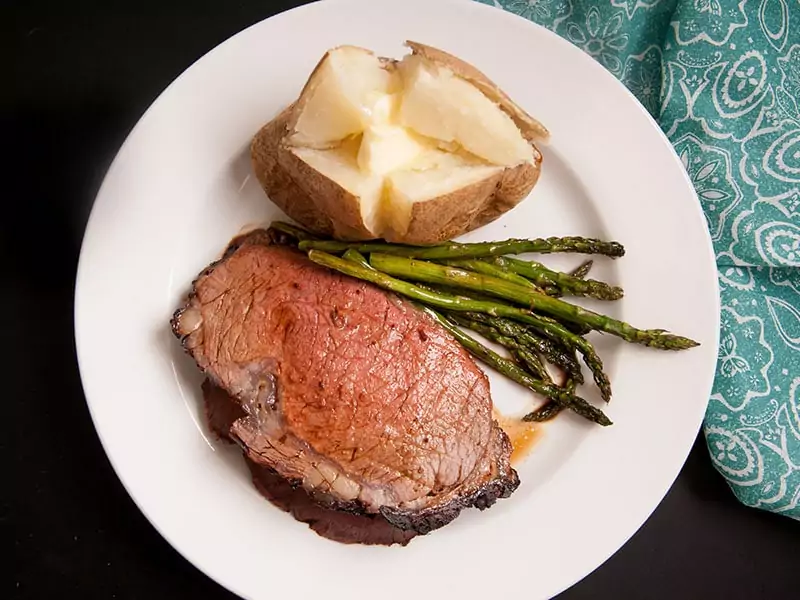
An oven is also an excellent pick for you. If you don't like reheating with water heat, you can choose to reheat it with an oven. Most people actually prefer an oven rather than a steamer as it almost helps to duplicate the original fabulous rosy red color of your prime rib.
Therefore, if you are an oven person, jump into this trick!
What You Should Prepare:
- Your oven
- Your prime rib
- Aluminum foil (optional)
- Roasting pan
- Au jus (or beef broth)
What You Should Do:
Step 1: Turn your oven on at about 250°F – 300°F. Give your oven time to warm up first.
Step 2: While waiting for your oven, take your prime rib out, put it into the roasting pan, and add some tablespoons of au jus (beef broth) on the top of the prime rib.
Step 3: Wrap the pan carefully with aluminum foil to make sure of the juiciness inside the meat.
Step 4: Pull your roasting pan into the oven and reheat it until it reaches your expected doneness. This step will take around 10 minutes.
Step 5: Take your prime rib out of the oven and remove the aluminum foil.
Step 6: Place your roasting pan on the stovetop and heat up the skillet to high heat.
Step 7: Add some butter to the pan, and wait until your prime rib sears a little. When you find your prime rib becoming crispy and turning brown from the outside, turn the stove off.
Step 8: Serve the prime rib on a plate. Add the juice from the roasting pan to the top of the meat. Triple the flavor with the au jus or beef broth again if you like.
Note: If you find the aluminum foil is unnecessary, use a lid to cover your roasting pan. (2)
You should see the video below:
3. A Microwave – Not A Bad Choice For Busy People
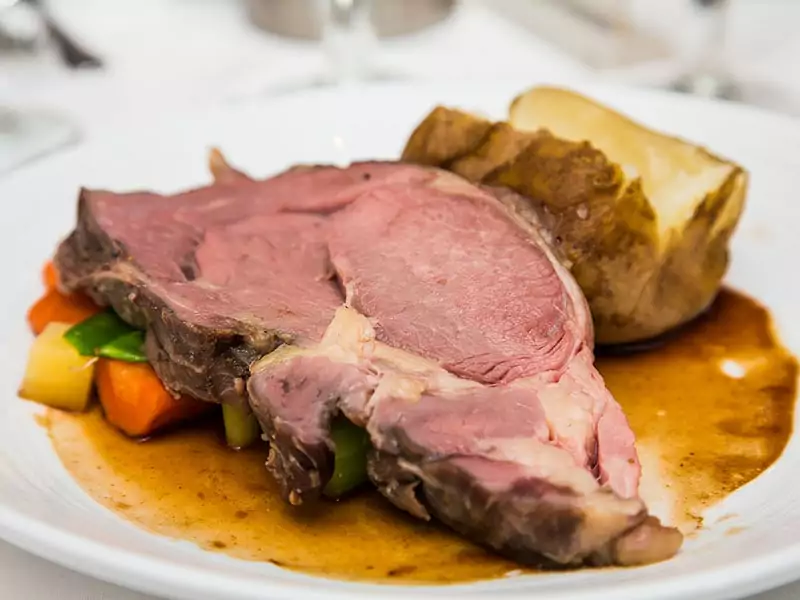
If you're too busy to whip up something delicious with unfinished ribs, the microwave reheating method absolutely belongs to you. Many professional chefs recommended that a microwave is not the ideal option for you to reheat prime rib. But it got nothing with the au jus!
Let's get started!
What You Should Prepare:
- Your microwave
- Prime rib, of course!
- Au jus or beef broth
- A food thermometer
What You Should Do:
Step 1: Put your prime rib into a microwave-safe bowl. Then, add a few tablespoons of au jus or beef broth into the top of the meat.
Step 2: Cover it with a lid and put the bowl into the microwave.
Step 3: Reheat your prime rib on high setting and leave it for about 1 minute.
Step 4: Take the meat out and use the food thermometer to check the inside temperature. If it still does not reach 160°F – 165°F, put it back in the microwave and reheat it again for about 30 seconds.
Step 5: After removing it from the microwave, serve it right away. Remember not to let the meat rest, or you will end up with an overheating prime rib.
4. Air Fryer – It's Not Only For Fried Dishes
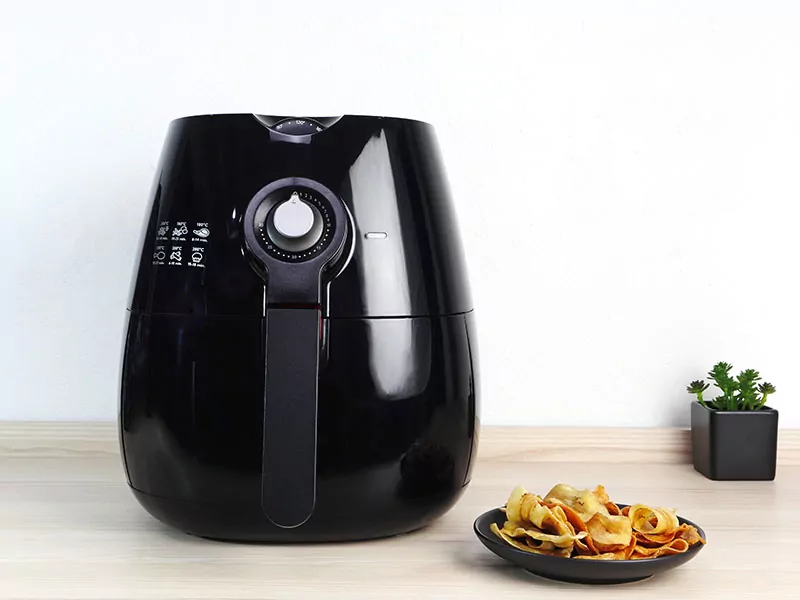
I bet fried foods have come to your mind when you see "air fryer", right? However, the air fryer is more useful than you thought. Scroll down to see how to reheat prime rib correctly with an air fryer!
What You Should Prepare:
An air fryer
Your precious prime rib
Au jus
What You Should Do:
Step 1: Preheat the air fryer at 200°F first.
Step 2: Wrap your prime rib in aluminum foil and add about 3 tablespoons of au jus to the top of your prime rib.
Step 3: Put your prime rib into the instant pot of the air fryer, then set up the pot.
Step 4: Increase the temperature of the air fryer to 300°F.
Step 5: Reheat your prime rib for about 10 minutes, then take it out of the air fryer immediately to avoid over-reheating.
Step 6: Serve it for your hungry belly right away!
5. Sous Vide – Reheat Like A Master
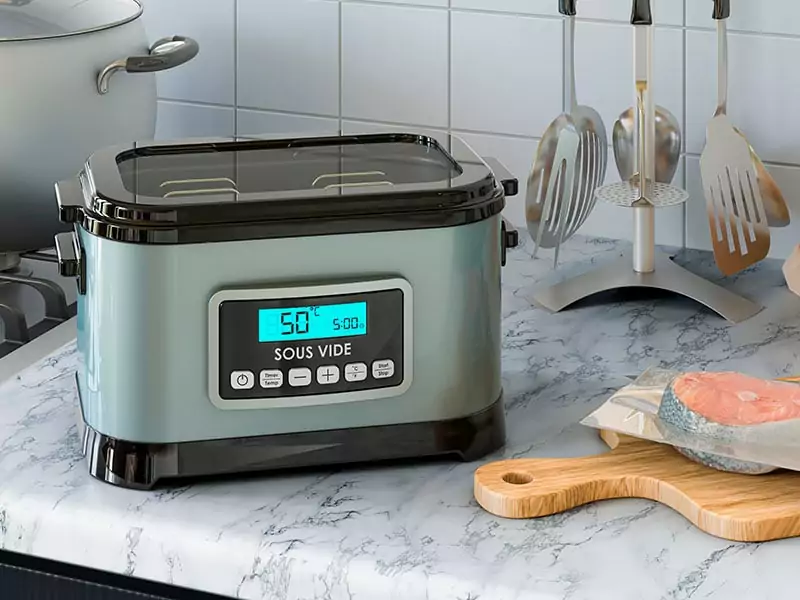
The sous vide method may not be very popular with home cooks, but it is the top choice of professional chefs. This method will help you reheat your prime rib by vacuum sealing and steaming.
Sous vide allows you to have delicious leftover prime rib without losing the moisture. Right now, I will show you how to reheat your prime rib using the sous vide method!
What You Should Prepare:
- Sous vide cooker
- Leftover prime rib
- A vacuum-sealed bag
- Au jus
What You Should Do:
Step 1: Put your prime rib in the vacuum-sealed bag.
Step 2: Add 1 tablespoon of au jus to the bag, then seal the bag carefully to prevent au jus from spilling out during the reheating process.
Step 3: Pour water into the sous vide cooker.
Step 4: Set the appropriate temperature of your sous vide cooker. If you have a medium rare leftover prime rib, set about 140º F. If it's a well-done prime rib, increase to 165º F.
Step 5: Put the prime rib bag in the sous vide cooker, then close the lid. Cook it slowly for about 1 hour.
Step 6: Take your prime rib out and serve it right away!
Take your prime rib out and serve it right away!
Reheating meat with a sous vide cooker is the most time-consuming method, but you would never want to go back to the normal reheating when you go-sous-vide. Sous vide cooker can keep almost exactly from the flavor, color to the texture of your food!
Note: With the sous vide method, if your leftover prime rib doesn't dry out, you may not need to add au jus.
You might still be unfamiliar with using a sous vide cooker? You can quickly learn how in this video!
"Behind The Screen" – Dos & Don'ts When Reheating Your Prime Rib
Before reheating your prime rib, there are a few things you need to keep in mind. Here are two things you should do and two things you shouldn't do when reheating your prime rib.
1. What You Should Do When Reheating Your Prime Rib
Check Out Your Leftover Prime Rib
If you have stored your leftover prime rib in the fridge for a long time, check out to see whether it's still safe to eat. If your prime rib smells strange or unpleasant, go to find other things for your meal.
Furthermore, it is best to only consume leftover prime rib within 3 – 4 days.
Potholder Is An Essential Item
Make sure you always have a few potholders on hand.
No matter which method you choose, the potholder is always the most essential item. They will protect your hands from getting burned when removing the prime rib from the oven, steamer, microwave, sous vide cooker, or air fryer.
Plus, buy the thick ones. Thin potholders do not work really well.
A Perfect Reheated Prime Rib With Food Thermometer
Again, if you want a perfect reheated prime rib, use a food thermometer to re-measure the temperature of your reheated prime rib. With this way you can prevent prime rib from overheating.
In addition, if you use a thermometer, you can reheat it if it hasn't reached the temperature you want.
2. Avoiding Bad Results With The Don'ts
I'm sure you wouldn't want anything unexpected to happen during the prime rib reheating process, would you? If yes, take note of the following suggestions!
Using Aluminum Foil In The Microwave
In this method, keep in mind that you SHOULD NOT use aluminum foil in the microwave to reheat the meat. According to the FDA, aluminum foils can heat up so quickly in the microwave that they even can ignite.(3)
Defrosting Frozen Prime Rib In Room Temperature
It is a fact that if you leave your frozen prime rib at room temperature between 40°F – 140°F, the bacteria that cause foodborne illness will grow quickly. There have been many cases of poisoning caused by foodborne illness in humans.
Therefore, I recommend that you should defrost your leftover prime rib in the refrigerator before reheating them.
FAQs
It's time for frequently asked questions! I'm sure you still have some problems about the reheating. Check out the list below to find out the solutions!
Additional Tips For Reheating Prime Rib
From this post, I believe reheating leftover prime rib does not trouble you anymore. And it is absolutely essential to know how to reheat your prime rib decently.
Not only can it help you to have a nutritious and delicious meal but also cut down the amount of your waste food as much as possible.
One another thing: Don't just end up with your prime rib alone. Roasted prime rib and fried potatoes are never outdated. And what else is more with a reheated prime rib sandwich? It makes many of my days!
At last, if you have any prime rib reheating tricks that are absent here, don't hesitate to share them in the comment section below. I would really appreciate that!
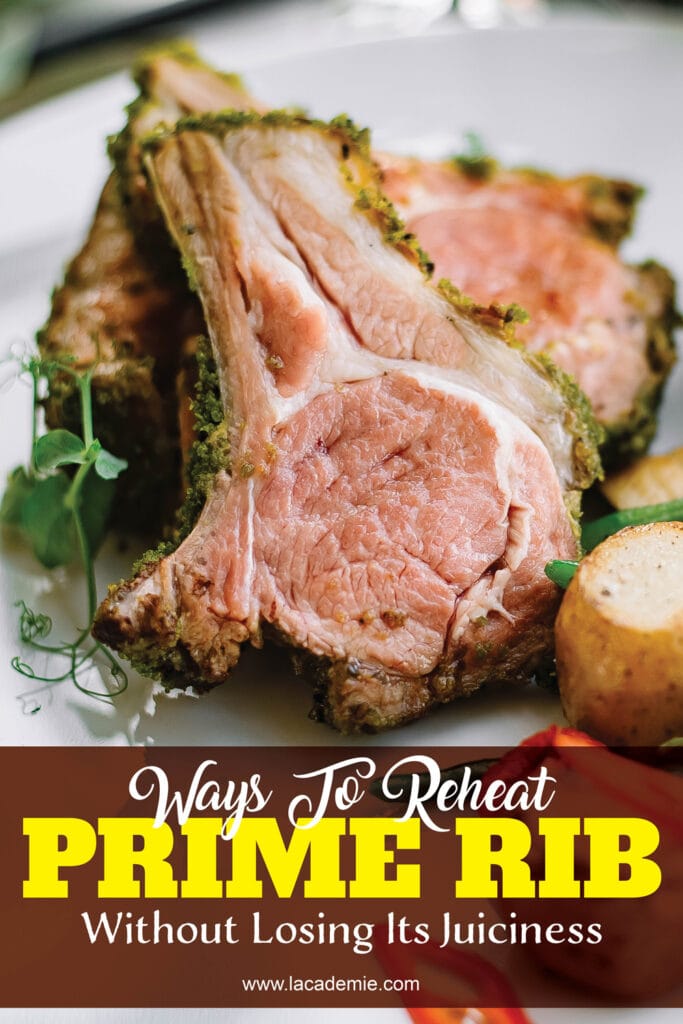
References
- Standing rib roast – Wikipedia. 2021.
- 3 Ways to Reheat Prime Rib – wikiHow. 2021.
- Reuters Staff – Fact check
Source: https://www.lacademie.com/how-to-reheat-prime-rib/